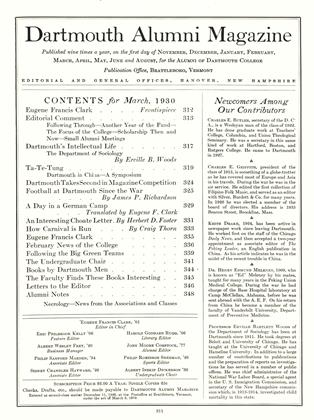By Ernest Staples Osgood '12. Minneapolis, The University of Minnesota Press, 1929. Pp. x, 283.
The cattle business of the western plains, with its exciting "round-ups" and "long drives," and with its adventurous and picturesque cowboys', has long offered an appealing field for those writers who are interested in vivid and dramatic action. Novels, descriptive works and autobiographies have found large and enthusiastic audiences. Only recently, however, have the historians and economists entered this fair land of romance. Mr. Osgood, as one of the younger historians interested in the westward expansion of the United States, has now given us a scholarly presentation of one part of the cattle business. His account deals primarily with the Wyoming-Montana region, and includes the early •development of the industry, its extent and financial importance, the formation and activities of the stock growers' associations, the relations between the stock growers and the Indians with the effect on the Indians and the situation in respect to the public domain. The story ends with the transition of the •cattle business to modern conditions. Numerous maps, charts and statistical tables help make the text understandable, while a good bibliography, footnotes and index make the critical apparatus complete.
The only real objection to Mr. Osgood's "book is that it seems to pretend to be something which it is not. Both the title and the general make-up of the volume label it as a general and somewhat popular account of the cattle industry. These indications are misleading. The field of the book is narrowly limited, while the style of the writing, although clear, concise and quite adequate, is by no means exciting. The presentation is •admirable for the historian, the economist, and for the general reader who is not content with a superficial view of the exciting phases of western life of the past. It is to be hoped that Mr. Osgood, or other equally competent historians, will complete the survey of the western cattle business, and will then carry it back to its origins much nearer the Atlantic seaboard.
 View Full Issue
View Full Issue
More From This Issue
-
 Class Notes
Class NotesCLASS OF 1909
March 1930 By Robert J. Holmes -
 Class Notes
Class NotesCLASS OF 1923
March 1930 By Truman T. Metzel -
 Article
ArticleTa-Te-Tung
March 1930 By Charles E. Butler -
 Lettter from the Editor
Lettter from the EditorEditorial Comment
March 1930 -
 Sports
SportsFootball at Dartmouth Since the War
March 1930 By James P. Richardson -
 Article
ArticleHow Carnival is Run
March 1930 By Craig Thorn
Robert E. Riegel
-
 Books
BooksMAKE EVERYBODY RICH
FEBRUARY 1930 By Robert E. Riegel -
 Books
BooksJoseph Hawley, Colonial Radical
DECEMBER 1931 By Robert E. Riegel -
 Books
BooksCOUNCIL FIRES ON THE UPPER OHIO
January 1941 By Robert E. Riegel -
 Books
BooksTHE DECLINE OF AMERICAN LIBERAL-
April 1956 By ROBERT E. RIEGEL -
 Books
BooksTHE INDIANS OF TEXAS IN 1830
JUNE 1969 By ROBERT E. RIEGEL -
 Books
BooksAMERICAN HEROINE: THE LIFE AND LEGEND OF JANE ADDAMS
October 1973 By ROBERT E. RIEGEL







